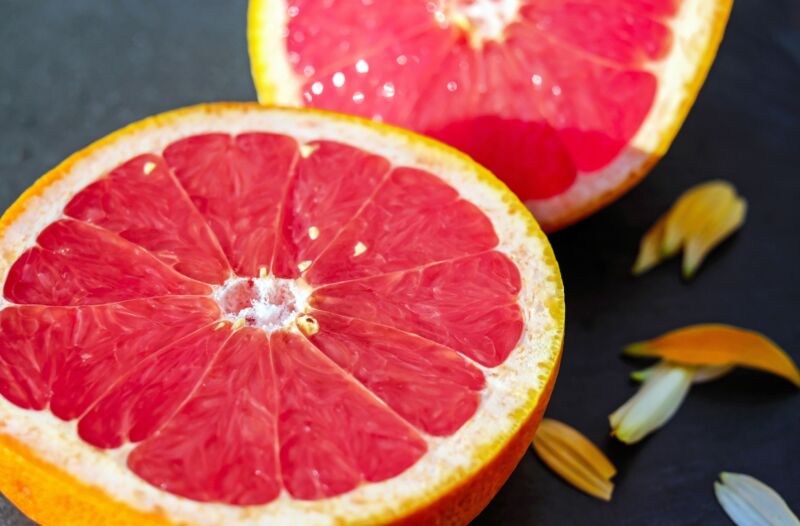Pomelo Vs. Grapefruit: What’s the Difference?
If you’re a citrus lover, you’ve probably enjoyed both pomelos and grapefruits. These two fruits look so similar that many people use the names interchangeably. However, pomelos and grapefruits are actually quite different.
In this article, I’ll explain everything you need to know about the differences between pomelos and grapefruits. We’ll look at their appearance, taste, nutrition facts, health benefits, uses, origin, and seasonality. I’ll also suggest other citrus fruits you may want to try if you enjoy pomelos and grapefruits.
Pomelo and Grapefruit Appearance
At first glance, pomelos and grapefruits can be hard to tell apart. They are both large, round citrus fruits with a similar thick rind. However, if you look closely, you’ll notice some key differences in their appearance.
Distinguishing Features of Pomelos
Pomelos have a few standout physical features:
- Thick green, yellow, or pink rind – The rind of a pomelo is thicker than that of a grapefruit. It can range in color from green to yellow to pinkish.
- Large pear shape – Pomelos are very large, usually weighing 2-4 pounds. They have a shape similar to a pear or gourd.
- Thick pith – The white flesh between the rind and fruit of a pomelo is quite thick.
Distinguishing Features of Grapefruits
Grapefruits also have some telling physical characteristics:
- Thin orange or yellow rind – The rind of a grapefruit is thin, smooth, and brightly colored. It ranges from yellow to orange.
- Round shape – Grapefruits have a nearly perfect spherical shape, similar to an orange. They are smaller than pomelos.
- Thin pith – The pith of a grapefruit is much thinner than that of a pomelo.
Differences in Flesh
If you cut open a pomelo or grapefruit, you’ll notice clear differences in the flesh:
- Pomelo flesh is pale yellow to pink in color. It is arranged in segments just like other citrus fruits. Due to their large size, pomelos have very large, meaty segments of flesh.
- Grapefruit flesh is yellow to deep pink and rich in natural pigments like lycopene. The flesh segments are small and tender.
Pomelo vs Grapefruit Taste
One of the biggest differences between pomelos and grapefruits is in their taste. Since they belong to the same citrus family, they have some similarities but also distinct differences.
Similarity in Taste
Pomelos and grapefruits have a similar genetic makeup since grapefruits originated as a hybrid of pomelos and oranges. As citrus fruits, they both have refreshing, tart and sweet flavors.
Grapefruit Taste Varies
The taste of a grapefruit really depends on its ripeness level. When fully ripe, grapefruits taste sweet and tart. Unripe grapefruits tend to taste very sour and bitter. As they ripen, they become sweeter.
Pomelo Taste is Consistently Sweet
Pomelos have a much more consistent sweet flavor. Unlike grapefruits, they do not taste sour or bitter even when unripe. The taste is more similar to other sweet citrus fruits.
Both Have a Classic Citrus Texture
No matter the level of sweetness, both pomelos and grapefruits have a juicy flesh and soft citrus pulp. They are refreshing and moist with a burst of flavor.
Nutritional Differences Between Pomelos and Grapefruits
Pomelos and grapefruits have some nutritional similarities since they belong to the same fruit family. But there are also some significant differences in their nutrition profiles.
Basic Nutrition Facts
In a standard serving size, pomelos tend to be higher in calories, carbohydrates, potassium, fiber, vitamin C, and protein compared to grapefruits.
For example, one pomelo (307g) contains:
- Calories: 311
- Total carbs: 25g
- Dietary fiber: 7g
- Potassium: 790mg
- Vitamin C: 160% DV
- Protein: 4g
One grapefruit (230g) contains:
- Calories: 122
- Total carbs: 15g
- Dietary fiber: 4g
- Potassium: 360mg
- Vitamin C: 120% DV
- Protein: 2g
As you can see, pomelos offer more significant nutritional value per serving.
Health Benefits
Both pomelos and grapefruits provide great health benefits. Here are some of their shared advantages:
- High in vitamins and minerals
- Rich in antioxidants like vitamin C
- Excellent source of fiber
- May promote weight loss
- Benefit heart health
Some unique benefits of each fruit include:
Pomelo:
- Anti-aging properties
- Natural anti-bacterial and anti-fungal properties
- Potential cancer-fighting antioxidants
Grapefruit:
- Boosts skin health
- Immune boosting vitamin C
- Hydrating and promotes kidney health
- May help prevent insulin resistance
So in terms of health perks, both fruits are nutritious choices!
How Pomelos and Grapefruits Are Used
You can take advantage of the tasty flavors of both pomelos and grapefruits in the kitchen and beyond. Here are some of the ways these fruits are commonly used:
Similar Uses
Pomelos and grapefruits share many of the same applications:
- Eaten raw by hand or sliced/segmented
- Made into fruit salads
- Used in savory recipes and parings, like seafood dishes
- Added to cocktails, juices, and smoothies
- Infused into baked goods like cakes and muffins
- Used as garnishes for sweet and savory foods
- Made into jams, marmalades, and preserves
- Used in body care products like soaps, masks, and aromatherapy
Best Pairings for Pomelos
Pomelos pair particularly well with:
- Fresh, mild produce like avocados and greens
- Sweet flavors like honey and vanilla
- Savory fish like tuna, mahi mahi, and salmon
Best Pairings for Grapefruits
Grapefruits pair nicely with:
- Bitter greens like arugula, radicchio, and endive
- Proteins like shrimp, chicken, pork, and beans
- Strong herbs like rosemary, sage, and thyme
Grapefruits can also be used as a substitute for oranges in many recipes. Their bold, tart flavor stands out in both sweet and savory dishes.
Where Pomelos and Grapefruits Come From
Pomelos and grapefruits have very different origins and ideal growing climates.
Pomelo Origins and Seasonality
Pomelos originated in Southeast Asia, specifically Malaysia and China. They also grow well in Israel and Fiji.
In the United States, most commercial pomelos come from Florida and California. The peak season for fresh pomelos runs from December to February.
Grapefruit Origins and Seasonality
The origin of grapefruits is uncertain, but they were likely first created in Barbados. Today, grapefruits grow abundantly in Florida, Texas, Arizona, and California.
Harvest times vary by location. In Florida and Texas, fresh grapefruits are in season from October to June. Arizona and California grapefruits are at their peak from January to August.
Similar Citrus Fruits You May Enjoy
If you like pomelos and grapefruits, there are many other delicious citrus fruits you should try:
- Tangelos – A cross between tangerines and grapefruits with a sweet and tart taste.
- Citrons – One of the original citrus species with aromatic rinds used for preserves.
- Yuzus – A cold-hardy fruit popular in East Asia with a grapefruit-like flavor.
- Rangpurs – Also called lemandarins, they taste like a mandarin-lime cross.
- Clementines – Mini sweet oranges with thin, deep orange rinds.
- Kumquats – An oval citrus fruit eaten whole – skin and all!
- Oroblancos – A sweet, seedless grapefruit and pomelo hybrid.
- Cara Caras – A type of navel orange with a hint of raspberry flavor.
Don’t be afraid to move beyond classic oranges and sample different citrus fruits. You’ll be rewarded with a lively medley of flavors!
Pomelos or Grapefruits: Which Will Be Your New Favorite?
Now that you know the key differences between pomelos and grapefruits, which one will you choose?
Pomelos offer a reliably sweet citrus taste with higher nutritional content. Grapefruits provide a nice balance of sweet and tart flavors.
Whichever you prefer, both make refreshing, healthy additions to your diet. Try incorporating these juicy citrus fruits into more recipes and enjoy their zesty taste.






